Читать книгу Global Approaches to Environmental Management on Military Training Ranges - Tracey Temple - Страница 40
На сайте Литреса книга снята с продажи.
2.3.4 Data evaluation and inference
ОглавлениеOnce the samples have been properly subsampled and analyzed, the analytical data needs to be reviewed to ensure that SQC was met. This will include not only the standard analytical quality control (QC) but also the QC associated with estimations of sampling and sample processing errors [22, 23]. A good test of the adequacy of the mass and the number of increments collected is to determine the confidence limits for replicate samples (3–5 reps are needed). If confidence limits are not met, the sampling error must be reduced by increasing mass and/or increments. For example, if the number of increments being collected in a project’s DUs is 50 increments and the confidence limits or relative standard deviation goals are not being met, it is likely that the number of increments is not being properly considered and will need to be increased. For similar sized increments, an increase in the number of increments will result in an increase in mass per sample, further reducing the sampling error.
After the data has passed the data evaluation step, inferences can be made. There may be only one inference or there may be many [16]. Each inference is performed separately. The inference may be as simple as using the single result from the laboratory to estimate the concentration in the DU or it may involve calculations such as the average from multiple test portions.
